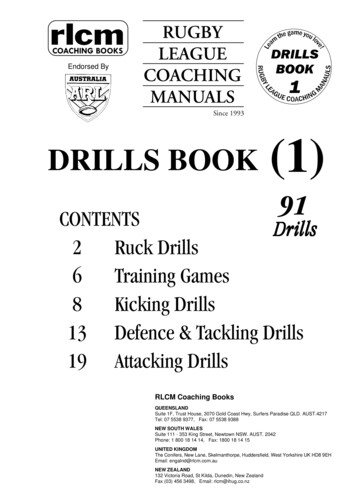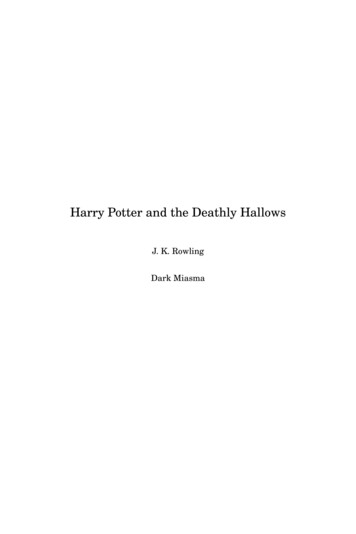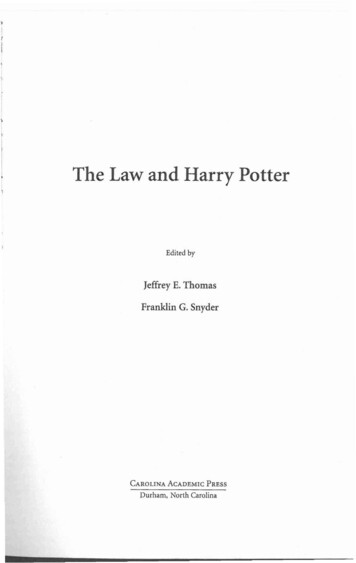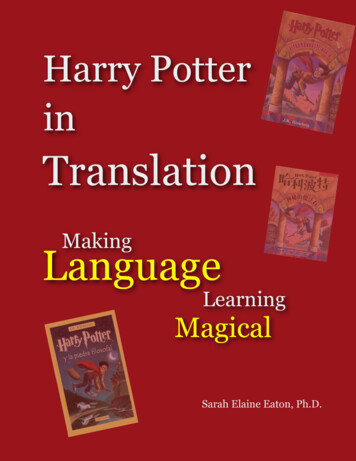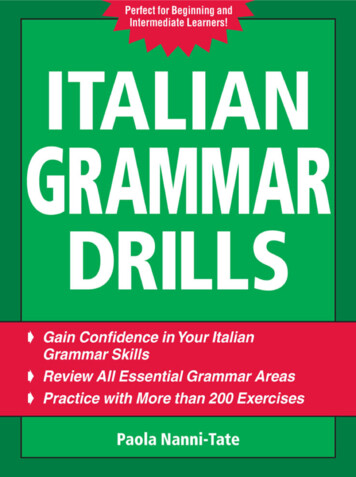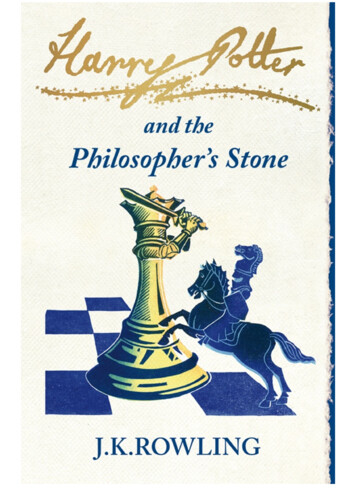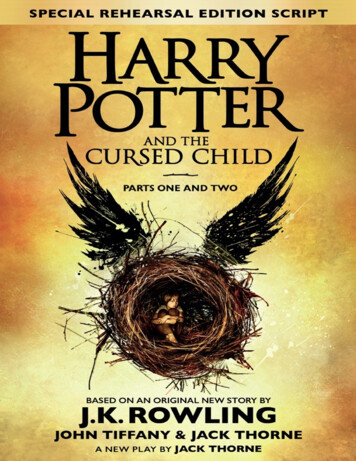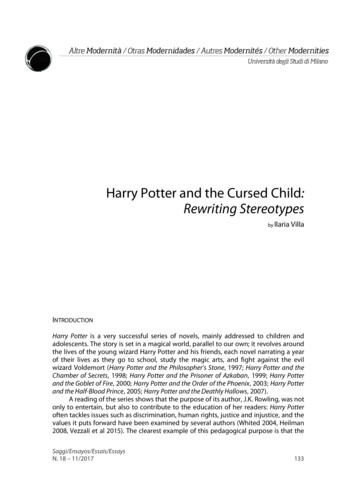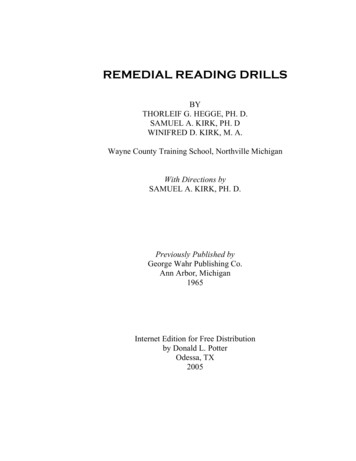
Transcription
REMEDIAL READING DRILLSBYTHORLEIF G. HEGGE, PH. D.SAMUEL A. KIRK, PH. DWINIFRED D. KIRK, M. A.Wayne County Training School, Northville MichiganWith Directions bySAMUEL A. KIRK, PH. D.Previously Published byGeorge Wahr Publishing Co.Ann Arbor, Michigan1965Internet Edition for Free Distributionby Donald L. PotterOdessa, TX2005
Previous Copyright Information:Copyright 1940, George Wahr.Reprinted: 1943, 1944, 1945, 1947, 1948, 1950, 1955, and 1963There is a 2007 highly revised 2 vol. edition currently available:Phonics Reading Lessons: Skills and PracticeAuthor: Samuel Kirk, Winifred Kirk, Esther Minskoff, PhD /Nancy Mather, PhD / Rhia Robertswww.academictherapy.comHistorical Note: There was a 1985 revision with Esther Minskoff, PhD listed asone of the authors. The 1985 editon says that the work was first published in 1936.This is also the date given in the bibliography of S. Kirk’s Teaching the SlowLearning Child to Read (Houghton Mifflin Co., 1940).
DIRECTIONSThe Remedial Reading Drills are designed primarily to aid children who have becomeretarded in reading. In applying these exercises the remedial teacher should first determine thestatus of the child and whether these exercises are applicable to his difficulties. In general, theexercises are most effective with children having the following characteristics: (1) the readingstatus of the child is below the fourth grade; (2) the child has a severe special reading disability;(3) the child is educable in sound blending; (4) any extreme visual or auditory defects have beencorrected; (5) the child is motivated and cooperative. In many cases cooperation may be difficultuntil some degree of success has been attained.HOW TO INTRODUCE THE METHOD TO THE CHILDBefore introducing the Remedial Reading Drills the teacher should spend the first few days insecuring the child’s cooperation, in showing him success, and in introducing the phonic methodrepresented by the Drills to him. The following suggestions may aid the teacher in achievingthese aims:1. Solicit the Child’s Cooperation. For children who have failed to learn to read, the greatestincentive is showing them success at all times and especially at the beginning of training. Forthis reason the teacher should always aim to present the child with a task that he will masterreadily. It will be noted that the drills have been constructed with this principle in mind.2. Introduce the Method Gradually. Before remedial training is begun the teacher shouldexplain to the child his difficulties as well as the new method which is to be used. The followingpreview of the method may be used to give the child fresh hope.The child is shown the letters s, a, c, t, and p, and if he is unfamiliar with the sounds of these letters, is taughtthem. For example, a may be written on the board. The instructor may tell the child that when a baby cries it says“a-a-a” (a as in cat). The letter is erased, and the child is asked to reproduce a in writing from memory, and to say aat the same time. This may be done several times. Then the child may be shown the letter s and told that it soundslike the hiss of a snake, “s-s-s-s”. Then the child may write s from memory and sound s at the same time. The letterss and a may be presented irregularly until the child knows both of these. Similarly, c, t, and p, are presented andworked upon until the child knows the five simple sounds. When this task is finished, the instructor may present thechild with the word c a t and have the child call out sounds one at a time. He is shown that these three sounds maybe blended into a word. Then the words cat, pat, tap, cap, at, sap, sat, are written on the board or on paper and thechild is aided in blending these sounds and calling out the words. It should be explained to the child that because heknows the sounds of five letters he can now readily read at least seven words. An explanation may follow in whichthe child is shown that he could start with short words and proceed to more complex words which he would soon beable to read as readily.With most children the procedure just outlined takes only a few minutes. The child now experiences success andrealizes that he can learn sounds fairly easily. Even with some children of subnormal intelligence this first period issufficient to teach the sounds of most of the consonants and of one or two vowels. Other slower learners may requirea week or even two or three weeks to reach the same stage. To insure success at the outset of training the childshould be presented only with tasks which he is able to master. Although simple, the pre-drill period is given as anextra precaution against any chance of failure.3. Teach or Review the Sounds of the Short Vowel a and Most of the Consonants. During thepre-drill period the child may be told that he must sound rather than spell words. He should firstbe taught the sound of the vowel a as described above. Consonants are introduced and taught inthe same manner, emphasizing the sounds which prove difficult for the individual child. Eachdifficult sound may be taught in the following manner:
The instructor should write the symbol t, for example, and should tell the child the sound of the symbol andassociate the sound with some concrete experience of the child. A picture of “teeth” from a toothpasteadvertisement, or the sound of a clock may aid the child to recall the sound. The child may then go to the board andwrite from memory the symbol t, sounding it at the same time. If it is a difficult sound he may write it several times,over and over again, saying the sound every time so as to familiarize himself with it graphically, visually, andvocally. Another consonant may be introduced and taught in the same manner. Then t may be re-introduced andalternated irregularly with the new sound, and so on. If the stimulus of a game is needed, the child may be asked tofind magazine pictures of objects beginning with that sound.When the sounds of most of the consonants and of the short vowel a have been taught inisolation, the next task is to train the child in the ability to blend sounds.4. Teach Sound Blending. The next problem which is likely to present itself is the child’sinability to blend sounds. In some cases the acquisition of this ability requires considerableattention.At first the child is shown by verbal demonstrations that c-a-t (sounds—not letters) say “cat.”Usually the child may learn by following the instructor on several words. It is essential, ofcourse, to give each letter the sound exactly as found in the word, avoiding any superfluoussound, such as the vocal additions often put at the end of the isolated sounds of b, k, p, (buh, kuh,puh) or at the beginning of m, n, l, r, etc. If some difficulty arises in blending the sounds into aword, the instructor may have to devote some time to this type of practice. The followingmethods are suggested:First, write the words c a t, s a t, m a t, on the board and have the child sound each letter in isolation. At first thechild should be allowed to vocalize the letters at his own rate of recall, then to repeat the sounds a little faster, thenstill faster until the blend is made. In other words, the child may be asked to sound the sequence of letters severaltimes at an increasing rate. This procedure may be necessary at first until the child is able to blend the sounds into aword fairly well. If this method does not produce results the following method may be tried.After the instructor has written a number of words, such as c a t, m a n, s a t, r a t, b a t, l a p, s a p, m a p, andhas aided the child in blending the sounds he may then dictate the words as wholes to the child by telling him towrite, for example, the word “cat.” If he does not know how to start he may be asked to say “cat,” and then asked totell with what sound the word “cat” starts. He may then say and write the sound c. Then “what is the next sound?”(demonstrate) “cat,” c-a-t, etc. In brief, allowing the child to dissect words and analyze their parts, then to writethem from dictation while saying them will aid him in blending sounds.Another device may be used as a variation from the other two. The child may sit with his back to the instructorand the instructor may sound words of two sounds at first, then of three sounds, and then of four sounds. Forexample, the instructor may first say, what word is m-ay, sh-e, b-e, etc. (sounding each element separately). If thechild is able to call out these words, increase the sounds to three letters such as b-a-d, s-a-t, etc. Another variation ofthis device is first to sound m-e, very rapidly. Then the word m-e may be said more slowly until there is a definitebreak between the sounds. The sounds may be given at the rate of two per second, and the time interval may beincreased to one sound per two or three seconds, for both two and three letter words.When the child knows the sounds of most consonants and the sound of the vowel a, and isable to blend three sounds into a word (even inadequately or slowly) he is ready to beginpracticing in the Remedial Reading Drills.DIRECTIONS FOR REMEDIAL INSTRUCTIONThe following directions are given to aid the teacher in the use of the Remedial ReadingDrills and supplementary exercises:1. Always Begin with Drill 1. After the initial training period the child should be ready forDrill 1. Allow the child to read this drill at his own rate. If it seems too easy for him, rememberthat success on it is another stone in building confidence.
2. Teach the Child to Respond to Individual Symbols. Although many systems of phonicsprefer combining the vowel with the last consonant, the Remedial Reading Drills should be readas indicated by the spacings, one letter at a time, sounding out c-a-t, “cat,” m-a-t, “mat,” etc.Combining the last two sounds may confuse the child by teaching him to carry over the last ofone word into the next word because of a perseverative tendency. If this occurs, the child shouldbe shown how to sound each symbol separately, i.e., s-a-t, “sat,” etc. At a later stage,combinations of blends are introduced in the drills to aid the child in reading more than onesound at a time. It has been found that slow accurate reading of the first drills makes for moreaccurate and more rapid blending of sounds later, and eventually for more efficient reading.3. All Drills Should Be Read Orally. This procedure is necessary for two reasons. The first isthat articulation serves as an aid to learning and retention. The second is that the oral readingprovides an opportunity for the teacher to note any erroneous responses and correct them at theirinitial appearance.4. Stress Accuracy and Disregard Speed. The child should read the drills only as fast as hecan read them accurately.5. Do Not Rush the Child or Allow Him to Skip Drills. If a child is forgetting previouslylearned material it is an indication that he is going too fast. Skipping large portions of each drillor completing too many drills in one lesson may cause the child to forget some of the soundswhen he meets them later.6. Present the Drills in the Order Given. The order of the drills should not be varied since thesounds of each drill are dependent upon what has gone before. Repetition is not necessarybecause of the frequent review drills and numerous repetitions of each word. Progress from pageto page is the child’s measure of success.7. Use the Grapho-Vocal Method. The grapho-vocal method refers to the method of teaching inwhich the child writes a letter or word from memory and says the sound of the letter or word atthe same time. The following procedure of using the method in connection with the drills isrecommended:Allow the child to continue reading from the drills until he shows signs of fatigue orinaccuracy. At this point, wherever it occurs, ask the child to stop reading and go to theblackboard. Then ask the child to write the difficult sound and at the same time to say the sound.Have him write it five or ten times while saying it so that he will become familiar with thesymbol and its sound. Then ask him to close his eyes while writing and saying it. Next dictatewhole words and ask the child to write them by saying out loud each sound as he writes itssymbol. Always have the child break up the whole word into separate sounds and sound eachsymbol while he is writing itThis method of saying the sound and writing it, then blending the sounds into a word, aidsretention, and also aids in the teaching of sound blending. It should be noted that the reading ofthe drills consists of saying isolated sounds and combining them into words. This is a syntheticprocess. Dictating words to the child for him to break up the whole word into its componentsounds is an analytic process. Thus the child may work on the drill words synthetically byreading the drills, then analytically by writing them from dictation by the grapho-vocal method.The grapho-vocal method may also be used to familiarize the child with a new sound beforeintroducing it in the drills.
8. Use Concrete Associative Aids. Another effective device for helping the child to learn anew sound is to associate the sound (and its symbol) with some concrete experience. For thesound of sh, for example, you may associate a mother or a teacher putting her finger to her lipsand saying “sh” when the children are making too much noise. Then when the child hasdifficulty with the sound in reading or in the drills, you may say, “What does your mother saywhen she’s afraid you’ll awaken the baby?” Usually the child responds by saying “sh” and at thesame time raising his finger to his mouth, but the overt motor response gradually decrease’s asthe sound is mastered.Similarly the sound of ou may be associated with a pinch, the short e with a deaf man puttinghis hand to his ear, etc. The teacher should find specific associative aids in relation to theexperiences of the particular child.9. When to Introduce Sentence Reading. Although the drills are very essential in remedialtraining, they in themselves, will not teach a child to read. They are essential in developingcorrect responses to written symbols, and also in giving the child a start in reading and anindependent attack on new words. Sentence and story reading, however, must be introduced tosupplement the drill material.No general rule can be given as to when sentence reading should be introduced. If a child issufficiently motivated and is able to read the drill material without becoming fatigued, very littlesentence reading should be introduced until the child has completed a number of drills. On theother hand, if the child requires variation in approach (i.e. variation from reading the drills,reading drill-words which the teacher writes on the board, or writing drill-words from dictation),sentence reading may be introduced even after Drill 1. If the teacher finds it advisable tointroduce this type of variation she may introduce, at any point in the drills, simple sentenceswhich include only those sounds already learned. Even after the completion of Drill 1 a child canread sentences such as “A man and a cat had a mat. A cat had a rat,” etc. Frequent words whichdo not occur in the drill system, as the, was, may be taught as word wholes and introduced overand over again in various sentences so that these words will become a part of the child’s readingvocabulary. Thus a teacher may ask the child to read in the drills to the point where he becomesfatigued and begins to make mistakes. She may then ask him to write words on the board by thegrapho-vocal method as described above. He may turn to the drills or he may read simplesentences which include words containing drill sounds. This variation should keep up theinterest of children who require such motivation.As the child progresses in the drills, more and more sentence reading can be given him. Shortstories composed of words containing only drill-sounds, with a few non-drill words taught asword-wholes, may be written by the teacher for the child to read. It should be explained to thechild that the symbol was says “was” (as a whole) in the same way as the sound of ee as in keepsays “ee”.10. When to Introduce Story Reading. Primers and first readers are too elementary in contentfor older children who have a reading disability. For these and other reasons it is frequentlyadvisable to eliminate the reading of stories from readers until the child is ready to read from amore advanced book. It is recommended that the reading of books be discontinued until the childhas covered at least the first twenty-six drills and preferably until he has completed the whole ofPart I. When the child has mastered this part of the drills he should be ready to begin readingfrom a second- or third-grade book. No definite time interval can be given since the advancementof the child depends upon the duration of the lesson, the number of lessons per week, and thelearning ability of the child. In some cases when thirty-minute individual lessons were given fivedays a week, these initial drills were covered in from two to four weeks. For children of slowerlearning ability Part I required from six to ten weeks of practice.
11. How to introduce Story Reading. Not all elementary readers are suitable for story readingeven after the child has completed Part I of the Drills. However, any book which is primarilyphonic and which is not too elementary in content for the child in question may be usedPrimers and picture stories are eliminated from the child’s reading lessons. This is quitenecessary for reading disability cases, since many of them have become very clever at readingstories from pictures without any reference to the words in the story. It is essential to train thechild to give all of his attention to the symbols, and therefore pictures are eliminated.The method of transferring the reading knowledge which has been acquired in the drills tostory reading is as follows:The teacher may ask the child to read, directing him to sound out every word that he does not know by sight.With these directions the child will face two major difficulties. The first is the reading of words which cannot besounded according to his present knowledge of sounds. There will also occur many words whose sounds are not inthe drills at all. In such cases the teacher should not allow the child to sound these words but should tell them to himand allow him to go on. This should be done for every word which the child does not know immediately and whichcannot be sounded. For example, if the child is reading the sentence, “Once there was a poor man who bad fivecows,” the teacher should say, “Once there was” (because these cannot be sounded by the child) and then allow thechild to sound the rest of the words. If he does not recognize the word who but begins to sound it phonetically, theteacher should just say “who.” This procedure eliminates confusion in reading.The second difficulty is that the child may forget a specific sound such as oo in the word poor. The teachershould not tell him the sound, but should point to or underline the configuration. Thus the child transfers theknowledge of the drill-sounds from the drills to book reading with the aid of the teacher. Although some childrenreadily make this transfer by themselves, others must be aided by the teacher. It should not be expected that a childwho can read keep, seen, etc., in the drills can readily read them out of a book. Thus the child reads the story fromthe book by sounding out all words which he can now sound, and by being told the other words by the teacher.12. Teach Non-Drill Words as Wholes. By the method given above the child graduallyacquires a reading vocabulary through two approaches. First, he may sound out the word cat, andlater, after several such soundings, may begin to recognize the word cat as a whole. Secondly, achild may learn some words, such as was because the teacher has told him the word over andover again in the story. The word incidentally becomes a part of his reading vocabulary. Practiceon some common words may, however, be necessary for the purpose of overcoming plateaus inlearning. The following method is recommended:After the child has been given a book to read, the teacher should keep a record of certain common words whichshe is forced to tell the child every time they occur in the story. The teacher will readily discover which words arestumbling blocks in the child’s reading. For these words special drill must be given. This may be done by variousmethods. First, the teacher may go over the story before the child reads, and may drill the child upon these words byasking him, “What is this word, what is this?” etc. If he is having trouble in remembering the words, he may go tothe board and write the words from memory. Or the teacher may type these words on small cards and present themto the child again and again by the flash-card method. This may be repeated from day to day until the words nolonger cause difficulties. This practice will have to be continued as other words come up throughout the remedialreading period. This should not be done, however, for words that can be sounded unless the child fails to learn thesewords as wholes after a great number of presentations in which he has had to sound out the word many times.The drills should not be dropped when story reading begins. On the contrary, the greaterproportion of the time of the remedial reading lesson should be devoted to the drills. The drillsshould be continued for the purpose of introducing new sound values and also for teaching thechild to combine small units into larger visual units. Instead of reading the word tan as t-a-n, thechild may learn to respond to the word t-an (sounding an as a whole).When Part III is reached the emphasis should be placed on reading and word study, ratherthan on phonic material. Nevertheless a short period of drill work each day should be continueduntil the drills are completed.
Table of ContentsPart IIntroductory SoundsDrill 1Drill 2Drill 3Drill 4Drill 5Drill 6Drill 7Drill 8Drill 9Drill 10Drill 11Drill 12Drill 13Drill 14Drill 15Drill 16Drill 17Drill 18Drill 19Drill 20Drill 21Drill 22Drill 23Drill 24Drill 25Drill 26Drill 27Drill 28Drill 29Drill 30Drill 31Drill 32Drill 33a (ă) b c d f g h j l m n p r s t xo (ŏ)Review of a, and oi (ĭ)Review of a, o, and iu (ŭ)Review of a, i, o, and uee (ē)sh (sh)oo (o͞o)ch (ch), and tch (ch)Review of ee, oo, sh, ch, and tchar (är)ay (ā), and ai (ā)or (ôr)old (ōld)Review of ar, or, old, ay, and aie (ĕ)Review of a, o, i, u, and eea (ē)oa (ō)ck (k)ow (ä o͝o), and ou (ä o͝o)Review of ea, oa, ck, ow, and ouLong Vowels of a (ā), i (ī), o (ō), and u (ŭ) with Final eGeneral Review of All Preceding Drillsing (ĭ)all (ôl)ight (īt)th (th), wh (hw), and qu (kw)er (ûr), ir (ûr), and ur (ûr)Review of ing, all, ight, th, wh, qu, er, ir, and ur.General Review of Part ITest Covering Part I
Part IICombination of SoundsDrill 34Drill 35Drill 36Drill 37Drill 38Drill 39Drill 40Drill 41Drill 42Drill 43Drill 44Drill 45an (ăn) in (ĭn) and un (ŭn)en (ĕn), and on (ŏn)ink (ĭnk), ank (ănk), and unk (ǔn)Review of an, in, en, on, ink, ank, and unk.ing (ĭng), ang (ăng), ong (ŏng), and ung (ǔng)and (ănd), ound (ä o͝ond), and est (ĕst)all (ôll), ill (ĭl), and ell (ĕl)Review of ing, ang, ong, ung, and ound, est, all, ill, and ellInitial Consonant CombinationsFurther Consonant CombinationsReview of Consonant CombinationsGeneral Review of Part IITest Covering IIPart IIIAdvanced SoundsDrill 46Drill 47Drill 48Drill 49Drill 50Drill 51Drill 52Drill 53Drill 54Drill 55aw (ô), au (ô), and ew (ū, o͞o)ook (o͝o), ind (īnd,), oy (oi), and oi (oi)-y (ǐ), -ly (lǐ), -le (l), and –ed (d,t)ge (j), ce (s), ci (s), and –cy (sǐ)Review of aw, au, ew, ook, ind, oy, oi, -y, -ly, -le, -ed, ge, ce, ci, and -cyaught (ôt), ough (ôt), pro- (prō), and other (ŭ th ēr)re- (rē), be- (bē), de- (dē) and pre- (prē)-sion (shŭn), -tion (shŭn), -ation (ā shŭn), -ution (ū shŭn)Review of aught, ought, pro-, other, re-, be-, pre-, -sion, -tion, and ution.Review of Part IIITest Covering Part III
Part IVSupplementary ExecisesExceptions to Configurations Previously TaughtExerciseExerciseExerciseExercise1234Exercise 5Exercise 6Exercise 7Exercsie 8Exercise 9Exercise 10Exercise 11Exercise 12Exercise 13Exercise 14Exercise 15Exercise 16Exercise 17Exercise 18Exercise 19Exercise 20Exercise 21Exercise 22Exercise 23Exercise 24Exercise 25Exercise 26Exercise 27Exercise 28Exercise 29Exercise 30Exercsie 31Exercise 32Exercise 33Exercise 34Exercise 35Exercise 36Exercise 37ea (ĕ)ow (ō)th (th)ive (ĭv)Configurations Not Previously Taughtkn (n), and gn (n)wr (r)ph (f)ould (o͝od)alk (ôk)alm (äm)ex (ĕx), con- (cŏn), and dis- (dĭ)-ous (ŭs), and –ful (fo͝ol)wor (wŭr)war (wôr)air (âr), and are (âr)eigh (ā)ie (ē)Monosyllables Ending in y (ī), or ie (ī)oil (ōl)oe (ō)o (ō) Ending, and e (ē) EndingWord Building Exercises and Compound WordsWord Buildingeverunderseapostschoolhouseoversome and comewhere and thereFinel e Dropped Before VowelsFinal e Kept Before Vowelsy Changing to ies, or iedPluralsExercises for Letter Confusionb, d, and pm and n
PART 1. Introductory SoundsDrill 1ab c d f g h j l m n p r s t ttagbancabtaprapsapSamwagfandad
Drill coblotpodtophogsobjogsodpoppotrotjogpop hotfob gotrob sobgotboblopbogpodlophodpopcogbobrot
Drill 3 — Reviewaosathogta glapbagsodranmanramtophamhatcapgo podpophotcoblapfatjobmannotpadcapcoghad
Drill ribdimsinhiplipribsipmixhidfix
Drill 5 — ptoprim
Drill ubsumcutrugrungumhuttubgunhutmud hugdug jutupcutpup ubcudsumbudnutnunmugcudjughubfunsumrunnuthumcup
Drill finbutdaddotsipcantuglo i aghag batmob tanwag himbob nmappitriphippopcudsixbatdaddamgot
Drills 8eed ee db ee rf ee ls ee kp ee pb ee td ee mf ee dd ee rh ee lw ee kw ee pf ee tt ee mh ee dj ee rr ee lp ee kk ee pm ee ts ee mn ee dl ee rk ee lm ee kd ee pf ee tt ee ms ee dp ee rp ee lr ee kw ee pm ee ts ee mr ee dd ee rp ee rs eew eek ee lr ee fd ee pp ee ls ee nw ee dk ee nr ee kd ee dp ee ks ee kw ee kk ee pr ee ld ee mp ee ps ee dw ee pk ee nr ee dd ee pp ee ls ee mw ee kk ee pd ee rb eeb ee rm ee ts ee kr ee dr ee fw eek ee lf ee lp ee rp ee lf ee tl ee kl ee rs eef eew ee dm ee kn ee efdeepleerkeeld ee ps ee nl eek ee nw ee kseepreedheeddeedfeedpeelkeepseemw ee dd ee rf ee ll ee kk ee pb ee td ee md ee dr ee kp ee kb ee tk ee pweepseemneedmeet
Drills 9shd a shm a shd i shg u shc a shr a shf i shm u shg a shs a shw i shh u shl a shd a shd i shr u shsh ee psh o dsh i psh ee tsh o tsh i nsh ee rsh o psh u nsh ee nsh o dsh u tsh ee psh o dc a shf i shsh u nh u shsh a md a shd i shsh i nm u shs a shsh ee nl a shsh i pg u shr a shsh ee rsh o pl a shsh ee tm a shsh ee tsh o tg a shw i shsh u tru ut
Drill 10oob oo tb oo nc oo lr oo mf oo dr oo fh oo ph oo tm oo nf oo ll oo mm oo dh oo fl oo pr oo ts oo nt oo ld oo mr oo dw oo fm oo rh oo tn oo np oo lb oo mf oo dr oo fp oo rr oo tb oo th oo tm oo rr oo mb oo nh oo fm oo nr oo db oo mh oo pm oo dr oo fb oo th oo fm oo nb oo tr oo fl oo ms oo nm oo rp oo rm oo nh oo pm oo dt oo lsh oo tt oo tc oo lb oo nh oo fd oo mn oo nd oo mr oo mh oo tl oo pr oo dp oo lw oo oonshoothootrootmoorcoolroomfoolf oo df oo lr oo tw oo fb oo mc oo lmoonboonloopwoofpoortootroodboom
Drill 11chtchch a pch i nch ee kch a tch i pch ee rch a ffch i llch ee rch a pch i nch ee kw i tchh a tchm u chp i tchc a tchs u chh i tchm a tchr i chi tchl a tchb ee chd i tchp a tchm u chr i chch ee kn o tchch i lll
practicing in the Remedial Reading Drills. DIRECTIONS FOR REMEDIAL INSTRUCTION The following directions are given to aid the teacher in the use of the Remedial Reading Drills and supplementary exercises: 1. Always Begin with Drill 1. After the initi
